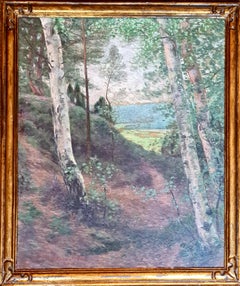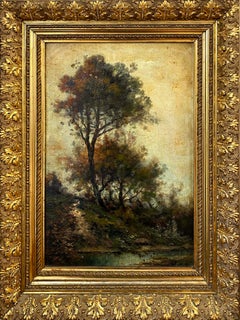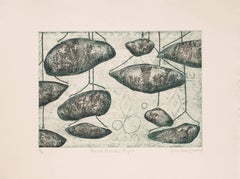Emile Roux Fabre Art
to
3
1
1
3
1
2
1
1
Overall Height
to
Overall Width
to
3
2
1
1
1
1
1
4
3
4
6,938
3,292
2,514
1,213
2
1
1
1
1
Artist: Emile Roux Fabre
The Forest, Large Barbizon School, Oil on Canvas Wooded Landscape
By Emile Roux-Fabre
Located in Cotignac, FR
A French Barbizon School oil on canvas forest view by Emile Roux-Fabre. The painting is signed and dated bottom left with a dedication.
A charming view of forest glade leading out to a valley landscape beyond. The artist has captured the magic feeling of the cool forest shade against the sunshine of the landscape beyond. The texture of the bark on the silver birch trees, the contrast of the leaves on the trees all framing the perspective to the view beyond. An extremely accomplished and atmospheric painting.
The Barbizon school of painters was part of an art movement towards Realism in art, which arose in the context of the dominant Romantic Movement of the time. The Barbizon school was active roughly from 1830 through 1870. It takes its name from the village of Barbizon, France, on the edge of the Forest of Fontainebleau, where many of the artists gathered. Most of their works were landscape paintings, but several of them also painted landscapes with farmworkers, and genre scenes of village life. Some of the most prominent features of this school are its tonal qualities, colour, loose brushwork, and softness of form.
The leaders of the Barbizon school were: Théodore Rousseau, Charles-François Daubigny, Jules Dupré, Constant Troyon, Charles Jacque, and Narcisse Virgilio Díaz. Jean-François Millet lived in Barbizon from 1849, but his interest in figures with a landscape backdrop sets him rather apart from the others. Jean-Baptiste-Camille Corot was the earliest on the scene, first painting in the forest in 1829, but his work has a poetic and literary quality which sets him somewhat apart. Other artists associated with the school, often pupils of the main group, include: Henri Harpignies, Albert Charpin, François-Louis Français and Émile van Marcke.
In 1824 the Salon de Paris exhibited works of John Constable, an English painter. His rural scenes influenced some of the younger artists of the time, moving them to abandon formalism and to draw inspiration directly from nature. Natural scenes became the subjects of their paintings rather than mere backdrops to dramatic events. During the Revolutions of 1848 artists gathered at Barbizon to follow Constable's ideas, making nature the subject of their paintings. The French landscape became a major theme of the Barbizon painters.
Millet extended the idea from landscape to figures — peasant figures, scenes of peasant life, and work in the fields. In The Gleaners (1857), for example, Millet portrays three peasant women working at the harvest. Gleaners are poor people who are permitted to gather the remains after the owners of the field complete the main harvest. The owners (portrayed as wealthy) and their laborers are seen in the back of the painting. Millet shifted the focus and the subject matter from the rich and prominent to those at the bottom of the social ladders. To emphasize their anonymity and marginalized position, he hid their faces. The women's bowed bodies represent their everyday hard work.
In the spring of 1829, Jean-Baptiste-Camille Corot came to Barbizon to paint in the Forest of Fontainebleau, he had first painted in the forest at Chailly in 1822. He returned to Barbizon in the autumn of 1830 and in the summer of 1831, where he made drawings and oil studies, from which he made a painting intended for the Salon of 1830; "View of the Forest of Fontainebleau'" (now in the National Gallery in Washington) and, for the salon of 1831, another "View of the Forest of Fontainebleau"'. While there he met the members of the Barbizon school: Théodore Rousseau, Paul Huet, Constant Troyon, Jean-François Millet, and the young Charles-François Daubigny.
During the late 1860s, the Barbizon painters attracted the attention of a younger generation of French artists studying in Paris. Several of those artists visited Fontainebleau Forest to paint the landscape, including Claude Monet, Pierre-Auguste Renoir, Alfred Sisley and Frédéric Bazille. In the 1870s those artists, among others, developed the art movement called Impressionism and practiced 'plein air' painting. In contrast, the main members of the school made drawings and sketches on the spot, but painted back in their studios.
The Post-Impressionist painter Vincent Van Gogh studied and copied several of the Barbizon painters as well, including 21 copies of paintings by Millet. He copied Millet more than any other artist. He also did three paintings in Daubigny's Garden.
The Barbizon painters also had a profound impact on landscape painting in the United States. This included the development of the American Barbizon school by William Morris Hunt. Several artists who were also in, or contemporary to, the Hudson River School studied Barbizon paintings for their loose brushwork and emotional impact. A notable example is George Inness, who sought to emulate the works of Rousseau. Paintings from the Barbizon school also influenced landscape painting in California. The artist Percy Gray...
Category
Early 20th Century Barbizon School Emile Roux Fabre Art
Materials
Canvas, Oil
Provence
By Emile Roux-Fabre
Located in Houston, TX
Classic etching of Provence by French artist E. Roux-Fabre, circa 1930.
Original artwork on paper displayed on a white mat with a gold border. Mat fits a standard-sized frame. Archi...
Category
1930s Emile Roux Fabre Art
Materials
Etching
French Etching Bridge
By Emile Roux-Fabre
Located in Houston, TX
French etching of arched bridge by artist E. Roux-Fabre, circa 1930.
Original artwork on paper displayed on a white mat with a gold border. Mat fits a ...
Category
1930s Emile Roux Fabre Art
Materials
Etching
Vintage Landscape Etching - The Flock
By Emile Roux-Fabre
Located in Houston, TX
Vintage black and white etching of a farmer leading his flock of sheep to a pasture bordered by a small village by French artist Emile Roux Fabre, circa 1930. Signed in pencil lower ...
Category
1930s Emile Roux Fabre Art
Materials
Paper, Ink
Related Items
Antique Barbizon School Oil Painting Original Gold Frame Rich Colors Fall
Located in Buffalo, NY
Original Barbizon school painting in an original period frame.
Framed 24 x 18
Unframed 18 x 12
Category
19th Century Barbizon School Emile Roux Fabre Art
Materials
Oil, Canvas
"Habitat Relocation Project" Etching on archival paper, botanical, floral
By Katie VanVliet
Located in Philadelphia, PA
intaglio with a la poupée on Somerset paper, unframed, edition of 6
Please message us directly if you are interested in a framed print.
Bio // Katie VanVliet is a sculptor and prin...
Category
21st Century and Contemporary Contemporary Emile Roux Fabre Art
Materials
Archival Paper, Etching, Intaglio
Mother dog and her puppies, 19th Century French Barbizonf armhouse painting
Located in Norwich, GB
An charming 19th century dog painting depicting a mother dogue and her exuberant topsy turvy pups by the farmhouse barns or cowsheds , with a young child given them a fuss!
Dating from ca 1860-70, the oil on canvas is unsigned, but bears on the verso a rather special stamp from colour and artists supplies merchant Paul Durand-Ruel (1831-1922). Paul Durand-Ruel is known as the legendary art dealer who launched, almost single handedly, the Impressionist movement. He represented Monet, Pissarro, Sisley, Renoir in his Paris, London and New York Galleries.
Like his father Jean Marie Durand, Durand Ruel had started as both a merchant of art supplies, and dealer. Often, these two activities overlapped, as he would supply cash strapped artists who left paintings as security. Paul Durand Ruel was one of the first to discover Barbizon artist...
Category
1860s Barbizon School Emile Roux Fabre Art
Materials
Canvas, Oil
H 27.17 in W 31.89 in D 0.4 in
Mountebank - XXI Century, Contemporary Figurative DryPoint Etching Print
By Czeslaw Tumielewicz
Located in Warsaw, PL
Polish painter and graphic designer, Czeslaw Tumielewicz was born in 1942.
In 1968, he studied at the Architecture faculty of Gdank, before continuing his course at the Technical Un...
Category
2010s Contemporary Emile Roux Fabre Art
Materials
Paper, Etching, Drypoint
River Cottage 1849/ Barbizon landscape heralding Impressionism Jongkind's friend
By Henri Sieurac
Located in Norwich, GB
A wonderful view of a river landscape with a rustic cottage and pollarded trees by Henri Sieurac. It isa rare, early and very fresh landscape by this Parisian artist which may well have been painted in the countryside around Barbizon, near the river Loing.
Henry Sieurac had studied with his father, François Joseph Sieurac , and of Paul Delaroche...
Category
1840s Barbizon School Emile Roux Fabre Art
Materials
Oil, Canvas
H 13.39 in W 16.54 in D 1.19 in
Bridge, Amsterdam
By James Abbott McNeill Whistler
Located in New York, NY
James McNeill Whistler (1834-1903), Bridge, Amsterdam, etching, 1889, printed in brown ink on thin laid paper, signed with the butterfly on the tab and annotated “imp”, also signed with the butterfly on the verso and numbered 11. References: Kennedy 409, Glasgow 447, fifth state (of 5). In very good condition (slight nicks at edges), trimmed by the artist on the plate mark apart from the tab, 6 1/2 x 9 1/2 inches.
Provenance:
Vivian and Meyer P. Potamkin, Philadelphia;
sale, Sotheby’s, New York, May 11, 1989, lot 302
Samuel Josefowitz, Pully, Switzerland
A very fine, shimmering impression of this great rarity.
This impression is included in the Glasgow inventory, ID number K4090301; only about 11 lifetime impressions in all states are known (three were also printed posthumously by Nathaniel Sparks...
Category
1880s Impressionist Emile Roux Fabre Art
Materials
Etching
"Manhattan Bridge" NYC American Scene Modernism Watercolor WPA Urban Realism
By Reginald Marsh
Located in New York, NY
Reginald Marsh "Manhattan Bridge" NYC American Scene Modernism Watercolor WPA Urban Realism, 20 x 14 inches. Watercolor and pencil on paper, 1938. Signed...
Category
1930s American Modern Emile Roux Fabre Art
Materials
Paper, Watercolor, Pencil
Burnt Ocean Waters, Abstract Diptych, Golden Yellow Pink, Mediterranean Seascape
By Ryan Rivadeneyra
Located in Barcelona, ES
Cyd Fontaine (Lausanne, 1992) is a contemporary artist renowned for her captivating use of dreamy atmospheric gradients, which has helped her carve a distinctive niche in the world o...
Category
2010s Contemporary Emile Roux Fabre Art
Materials
Photographic Film, Archival Ink, Photographic Paper, C Print, Digital, G...
Free Shipping
H 36 in W 48 in
Rough Weather at Blatchington Pulling in the Fishing Nets on the English Coast
By Sir Frank Short
Located in Soquel, CA
Drypoint etching rawing of a coastal scene with figures drawing a net or boat form the sea by Sir Francis (Frank) Job Short (British, 1857 - 1945)
Sir Frank Short, Royal Academy*, was a printmaker and teacher of printmaking. He revived the practices of mezzotint* and aquatint* engraving, and also wrote about printmaking to educate a wider public.
Signed "Frank Short" lower right with monogram in the print "S within a shield"
Titled lower left "Rough Weather at Blatchington"
Lower left "Trial Proof"
Image, 8.5"H x 10.88"W
Mat, 16"H x 20"W x 0.13
Professionally cleaned and ph nuetral washed by our paper conservator. (new images posting)
Francis Job Short was born on 19 June 1857 in Britain, at Stourbridge, Worcestershire. He was educated to be a civil engineer.
He was engaged on various works in the Midlands until 1881, when he came to London as assistant to Mr Baldwin Latham in connection with the Parliamentary Inquiry into the pollution of the river Thames. In 1883 he was elected an associate member of the Institution of Civil Engineers. Having worked at the Stourbridge School of Art in his early years he joined the South Kensington School of Art*, in 1883. He also worked at the life class under Professor Fred...
Category
1870s Impressionist Emile Roux Fabre Art
Materials
Drypoint, Etching, Gouache, Rag Paper
Sir Frank ShortRough Weather at Blatchington Pulling in the Fishing Nets on the English Coast, 1870s
H 16 in W 20 in D 0.13 in
14 Przedborska Street - XXI Century, Contemporary Etching Print, City view
By Zdzislaw Wiatr
Located in Warsaw, PL
ZDZISŁAW WIATR (born 1960)
He graduated from the Academy of Fine Arts in Cracow, at the Faculty of Graphic Arts in Katowice, where in 1986 he received a diploma with the honourable m...
Category
21st Century and Contemporary Contemporary Emile Roux Fabre Art
Materials
Paper, Etching
Blustery Clouds, Stormy Sky Landscape, Blue Tones, Extra Large Cyanotype, Paper
By Kind of Cyan
Located in Barcelona, ES
This is an exclusive handprinted limited edition cyanotype.
"Blustery Clouds" is an cyanotype of the semi-abstract patterns of clouds in the sky after a storm.
Details:
+ Title: Blu...
Category
2010s Realist Emile Roux Fabre Art
Materials
Photographic Film, Lithograph, Emulsion, Ink, Watercolor, Photographic P...
La rentrée du Berger by Camille Pissarro - Etching
By Camille Pissarro
Located in London, GB
La rentrée du Berger by Camille Pissarro (1830-1903)
Etching
7.6 x 10.9 cm (3 x 4 ¹/₄ inches)
Stamped with initials C.P. lower left, and numbered 13/18 lower right
This work was crea...
Category
1880s Impressionist Emile Roux Fabre Art
Materials
Etching
Emile Roux Fabre art for sale on 1stDibs.
Find a wide variety of authentic Emile Roux Fabre art available for sale on 1stDibs. You can also browse by medium to find art by Emile Roux Fabre in etching, canvas, fabric and more. Not every interior allows for large Emile Roux Fabre art, so small editions measuring 16 inches across are available. Customers who are interested in this artist might also find the work of Theophile Narcisse Chauvel, Jean François Millet, and Charles François Daubigny. Emile Roux Fabre art prices can differ depending upon medium, time period and other attributes. On 1stDibs, the price for these items starts at $225 and tops out at $906, while the average work can sell for $250.


